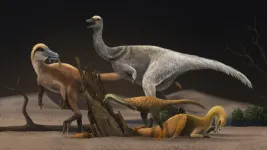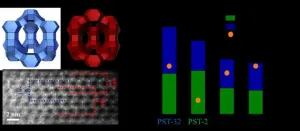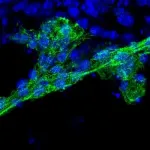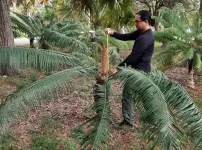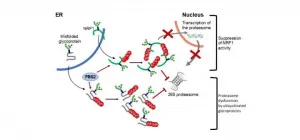(Press-News.org) Dinosaurs were generally huge, but a new study of the unusual alvarezsaurs show that they reduced in size about 100 million years ago when they became specialised ant-eaters.
The new work is led by Zichuan Qin, a PhD student at the University of Bristol and Institute of Vertebrate Paleontology and Paleoanthropology in Beijing. He measured body sizes of dozens of specimens and showed that they ranged in size from 10-70 kg, the size of a large turkey to a small ostrich, for most of their existence and then plummeted rapidly to chicken-sized animals at the same time as they adopted a remarkable new diet: ant-eating.
The alvarezsaurs lived from the Late Jurassic to Late Cretaceous (160 to 70 million years ago) in many parts of the world, including China, Mongolia, and South America. They were slender, two-legged predators for most of their time on Earth, pursuing lizards, early mammals, and baby dinosaurs as their diet.
"Perhaps competition with other dinosaurs intensified through the Cretaceous," says Prof Michael Benton, one of Zichuan's supervisors, at Bristol's School of Earth Sciences. "The Cretaceous was a time of rapidly evolving ecosystems and the biggest change was the gradual takeover by flowering plants. Flowering plants changed the nature of the landscape completely, and yet dinosaurs mostly did not feed on these new plants. But they led to an explosion of new types of insects, including ants and termites."
This restructuring of ecosystems has been called the Cretaceous Terrestrial Revolution, marking the time when modern-style forests and woodlands emerged, with diverse plants and animals, including insects that specialised to pollinate the new flowers and to feed on their leaves, petals and nectar.
A key problem with many alvarezsaur specimens, especially the chicken-sized ones, was to be sure they were all adults. "Some of the skeletons clearly came from juveniles," says Dr Qi Zhao, a co-author and an expert on bone histology, "and we could tell this from sections through the bone. These showed the ages of the dinosaurs when they died, depending on the number of growth rings in the bone. We were able to identify that some specimens came from babies and juveniles and so we left them out of the calculations."
Ant-eating might seem an amazing diet for dinosaurs. "This was suggested years ago when the arms of Mononykus were reported from Mongolia," says Professor James Clark in Washington, DC, a co-author of this paper, and also one of the first discoverers of tiny alvarezsaurs from Mongolia. "Mononykus was one of the small alvarezsaurs, just about 1 metre long, but probably weighing 4-5 kilograms, a decent-sized Christmas turkey. Its arm was short and stout and it had lost all but one of its fingers which was modified as a short spike. It looked like a punchy little arm, no good for grabbing things, but ideal for punching a hole in the side of a termite mound."
"Interestingly, alvarezsaur dinosaurs were indeed not small in size or ant eaters at start," says Professor Jonah Choiniere in South Africa, a co-author of this paper, who was first to report the earliest alvarezsaurs in China. "Their ancestors, like Haplocheirus, are relatively large, close to the size of a small ostrich, and their sharp teeth, flexible forelimbs and big eyes suggest they had a mixed diet."
Zichuan Qin took all the measurements of body size and mapped these across a dated evolutionary tree of the alvarezsaurs. "My calculations show how body sizes went up and down for the first 90 million years they existed, ranging from turkey to ostrich-sized, and averaging 30-40 kg," says Zichuan. "Then, 95 million years ago, their body size suddenly dropped to 5 kg, and their claw shapes changed from grabbing and cutting to punching."
"This is a very strange result, but it seems to be true," says Professor Xing Xu, a co-supervisor to Zichuan in Beijing. "All other dinosaurs were getting bigger and bigger, but one group of flesh-eaters miniaturized, and this was associated with living in trees and flying. They eventually became birds. We've identified a second miniaturization event - but it wasn't for flight, but to accommodate a completely new diet, switching from flesh to termites."
INFORMATION:
The paper
'Growth and miniaturization among alvarezsauroid dinosaurs' by Zichuan Qin, Qi Zhao, Jonah N. Choiniere, James M. Clark, Michael J. Benton and Xing Xu. Current Biology
An international team of scientists has used high-powered X-rays at the European Synchrotron, the ESRF, to show how an extinct South African 200-million-year-old dinosaur, Heterodontosaurus tucki, breathed. The study is published in eLife on 6 July 2021.
In 2016, scientists from the Evolutionary Studies Institute at the University of the Witwatersrand in Johannesburg, South Africa, came to the ESRF, the European Synchrotron in Grenoble, France, the brightest synchrotron light source, for an exceptional study: to scan the complete skeleton of a small, 200-million-year-old plant-eating dinosaur. The dinosaur specimen is the most complete fossil ever discovered of a species known as Heterodontosaurus tucki. The fossil was found in ...
At the end of life, people may have to rely on others for help with showering, dressing and going to the toilet. This loss of privacy and independence can be confronting and difficult.
Now Australian occupational therapy (OT) researchers have interviewed 18 people receiving palliative care about how they feel about losing independence with self-care, specifically their intimate hygiene, as function declines with disease progression.
The study aims to raise awareness of how to provide better care for people at the end of life.
Lead researcher Dr Deidre Morgan, a Flinders University occupational ...
A research team at POSTECH has uncovered a promising new zeolite, anticipated to be a turning point for the oil refining and petrochemical industries. This research was recently published in the scientific journal Science on July 2, 2021.
The team of researchers led by Suk Bong Hong, a professor in the Division of Environmental Science and Engineering at POSTECH, synthesized two thermally stable three-dimensional (3D) large-pore (12-ring)1 zeolites - PST-32 (POSTECH No. 32) and PST-2, the hypothetical SBS/SBT intergrowth structure2 - by using the "multiple inorganic cation" and the "charge density mismatch" synthetic strategies, respectively. The research team identified their structures by using both powder X-ray diffraction ...
New research in BMC Cancer has shown myelosuppressive chemotherapy destabilises gut microbiome in patients with solid organ cancers.
The study from SAHMRI and Flinders University assessed the gut health of men and women who underwent conventional chemotherapy on cancers, such as breast and lung cancer, without exposure to antibiotics.
"We know that myelosuppressive chemotherapy reduces white blood cell count significantly during the first seven to 10 days of treatment, making the body more vulnerable to infection," says lead author Dr Lito Papanicolas, an infectious diseases expert and clinical microbiologist.
"In this study we focused on how much the individual's microbiome changed over this period, when the ...
Scientists at UC San Francisco have shown that gene-edited cellular therapeutics can be used to successfully treat cardiovascular and pulmonary diseases, potentially paving the way for developing less expensive cellular therapies to treat diseases for which there are currently few viable options.
The study, in mice, is the first in the emerging field of regenerative cell therapy to show that products from specially engineered induced pluripotent stem cells called "HIP" cells can successfully be employed to treat major diseases while evading the ...
A 15-year reciprocal transplant study on Guam's native cycad tree, Cycas micronesica, by the Plant Physiology Laboratory at the University of Guam's Western Pacific Tropical Research Center has revealed that acute adaptation to local soil conditions occurs among the tree population and is important in the survival rate of transplanted cycads. The results show that 70% to 100% of cycads that were transplanted in local conditions survived versus less than 10% that were transplanted in foreign conditions. The article describing the study has been published in the peer-reviewed journal Diversity (doi: 10.3390/d13060237).
Transplantation ...
Vertical greenery 'planted' on the exterior of buildings may help to buffer people against stress, a Nanyang Technological University, Singapore (NTU Singapore) study has found.
The benefits of nature on mental health and for wellbeing have long been recognised, and now a team of NTU Singapore psychologists has used Virtual Reality (VR) to examine whether vertical greenery has a stress buffering effect (ability to moderate the detrimental consequences of stress) in an urban environment.
Using VR headsets, 111 participants were asked to walk down a virtual street for five minutes. Participants were randomly assigned to either a street that featured rows of planted greenery (e.g., on balconies, walls, and pillars of buildings), ...
Attention training in young people with autism can lead to significant improvements in academic performance, according to a new study.
Researchers at the University of Birmingham in the UK along with institutions in São Paolo, in Brazil, tested a computer programme designed to train basic attention skills among a group of autistic children aged between eight and 14 years old.
They found participants achieved improvements in maths, reading, writing and overall attention both immediately after undergoing the training and at a three-month follow up assessment. Their results are published in Autism Research.
Lead researcher, Dr Carmel Mevorach, in the University of Birmingham's Centre for Human Brain Health, and School of Psychology, says: "It's ...
The urgency to remember a dangerous experience requires the brain to make a series of potentially dangerous moves: Neurons and other brain cells snap open their DNA in numerous locations--more than previously realized, according to a new study--to provide quick access to genetic instructions for the mechanisms of memory storage.
The extent of these DNA double-strand breaks (DSBs) in multiple key brain regions is surprising and concerning, said study senior author Li-Huei Tsai, Picower Professor of Neuroscience at MIT and director of The Picower Institute for Learning and Memory, because while the breaks are routinely repaired, that process may become more flawed and fragile with age. Tsai's lab has shown that lingering DSBs are associated with neurodegeneration ...
Peptide: N-glycanase (NGLY1) is an evolutionarily conserved enzyme for removing N-linked glycans (N-glycans) from glycoproteins and is involved in proteostasis of N-glycoproteins in the cytosol. In 2012, a rare genetic disorder called NGLY1 deficiency was discovered by an exome analysis. Symptoms in patients with NGLY1 deficiency include global developmental delay, hypotonia, hypo/alacrima, movement disorder, scoliosis, abnormal liver, brain functions and peripheral neuropathy. Unfortunately, no therapeutic treatment is currently available to this devastating ...
